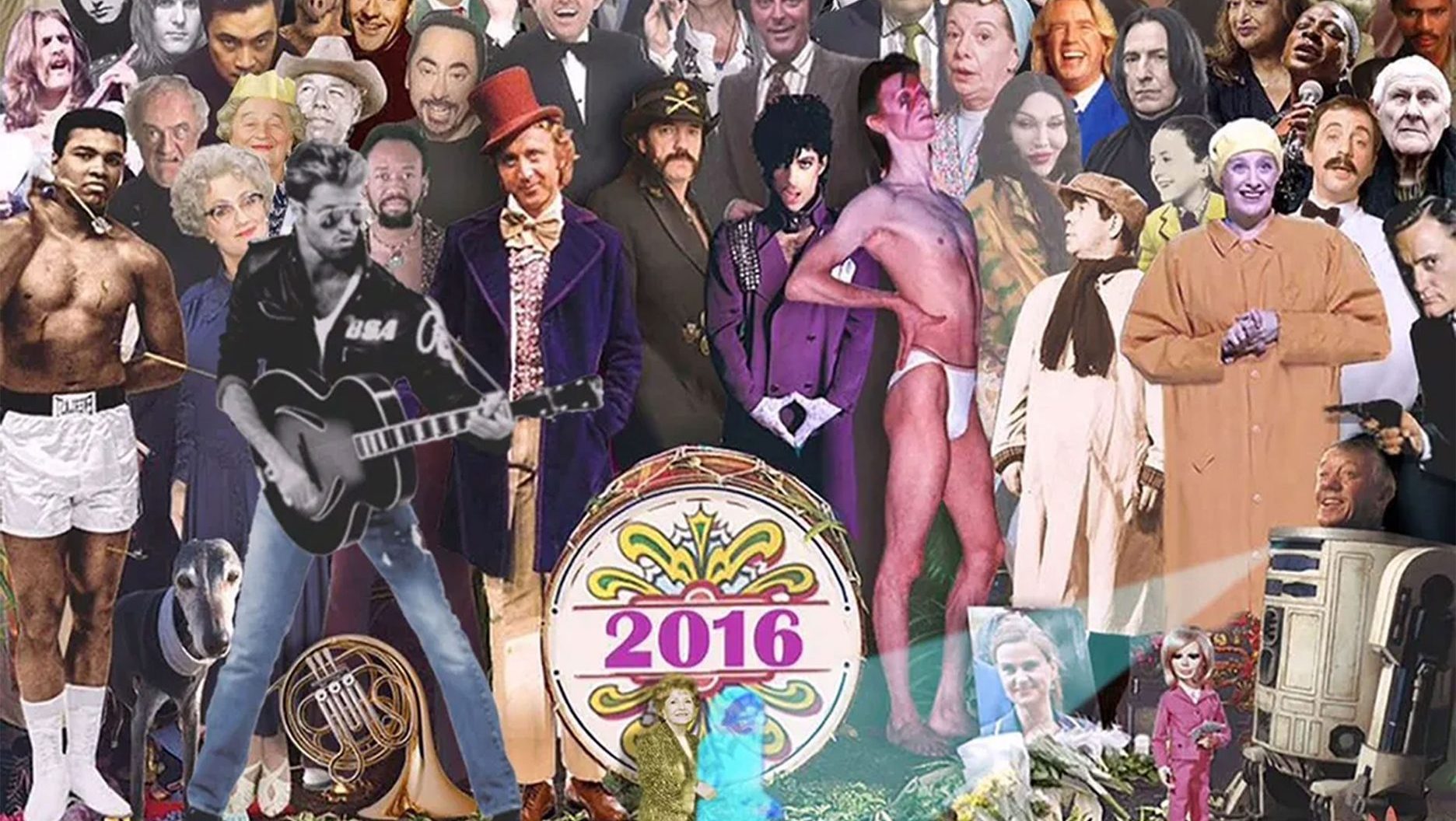It was the evening of the US election, and I planned to stay up late to watch the Americans elect their first female president. Or so I thought. But this was 2016. We’d already had Brexit, Bowie dying, Leicester winning the league. Nothing was going to go to plan.
As the night started to take on an ominous tone, I began thinking about making something that reflected what an unusual, dystopian year it had been. It wasn’t originally going to be a Sgt Pepper album cover parody. It wasn’t originally going to be just dead people. But then – for one reason or another – it was. I posted it online and sat back to watch the chaos unfold.
At the time, I only had about 350 followers on social media. For me, going viral was getting a reply to a tweet. So when this blew up and I had to do press every morning before work, it took me by surprise.
There’s a tendency to mythologise things after the event, but I genuinely remember sitting and taking a breath before I started the image, thinking, “Right, if I’m going to do this, I should do it properly.” I thought it might get attention, but I didn’t honestly think I’d still be talking about it ten years later. On the telly.
A couple of days after I posted the image, Leonard Cohen died, which meant I had to update it to include him. And it went viral again. Then Robert Vaughn from The Man from UNCLE died a few days later. These were bona fide sixties icons – how could I not include them?
And then people just kept dying: Caroline Aherne, Rick Parfitt, George Michael on Christmas Day, and then the gut-punch of Carrie Fisher, followed by her mother, Debbie Reynolds, at the end of the year. The whole world was reeling from this strange phenomenon, and everyone wanted to talk about it. Because my montage was there, it became the focus of this outpouring of national – and international – grief.
“With viral ‘celebrity death’ art, social media has finally gone full Warhol,” wrote the Washington Post a couple of weeks in. Your actual Washington bloody Post comparing me to Warhol! Ironically, given the subject, it had become a living piece of art.
The following year, people begged me to do it again, but I resisted. I thought it had its place in history and should be left alone. But then Roger Moore died. The outpouring of emotion and anecdotes felt almost – but not quite – akin to when Bowie died.
A few weeks later, I was in a meeting when I heard that legendary Batman actor Adam West had died. That’s when I started seriously considering doing it again. You’ve got a Batman, a Bond, and – technically – a Doctor Who in John Hurt, who had played the Doctor in the 50th-anniversary special a few years earlier. This is cult royalty.
With the addition of rock royalty Tom Petty later in the year, I was struggling not to picture the image in my head. I thought I could use it to highlight climate change, to try and spread a message. It worked to a certain degree, but most people were still just using it to play dead celebrity Where’s Wally?
So, to cut a long story short: despite my protests, it became an annual thing. People loved it. They looked forward to it like the Morecambe and Wise Christmas special – or at least the Christmas edition of the Radio Times. It became an end-of-year staple.
Around the world, I had journalists I spoke to once a year. This publication started running it as a front cover. I had a regular slot on BBC News. I gained thousands of social media followers.
So why give all that up?
There are a number of reasons this year’s montage will be the last. I never wanted it to become a chore. I used to put them together in a week or so, but now it takes more and more time each year.
The number of people included has more than doubled since the first one. I don’t think twice the number of people have died; I’ve just become more completist about it.
It has fans who feel ownership over it. If I miss their personal favourite, they get upset. I don’t like upsetting people, so I work much harder now – and that’s a lot of pressure.
Ten seems like a good, round number. I said in 2016 I’d never do it again – and again in 2018, 2019. I don’t want to do it forever. The people included are getting closer to my generation. Personally, it would be a bit much if I ended up doing a Sgt Pepper montage with Damon Albarn and Jarvis Cocker on the front row.
As a friend once said, what are you going to do – keep going until one year you leave it half-finished and someone has to add you into it? I’m sure AI will be able to make them soon anyway, and people can just pop a spreadsheet into ChatGPT and create their own montage – avoiding any debate about who goes where.
The main reason I’m stopping this year is Charlie Kirk – or, more specifically, my shock at the reaction to his death. Society has changed a lot in the last ten years.
Suggested Reading

Charlie Kirk: A death on the internet
Looking back at the montages from 2016–2024 is like a visual history of how the world has evolved. They cover everything from Covid to Gaza, the Queen dying to Grenfell Tower. Researching them for my upcoming book reminded me of stories I might otherwise have forgotten.
It’s also a reminder of how attitudes have shifted. I included a poppy on the Sgt Pepper drum in 2018 to commemorate 100 years since the end of WWI. I probably wouldn’t do that now. Society has become so polarised that even the poppy – a neutral motif of remembrance – has been distorted into a symbol of militarism and nationalism.
So, why Charlie Kirk? I’ll be honest: I wasn’t very aware of him before he died. I’d seen the memes, but I didn’t realise how influential he was. When he was shot, I thought, ‘well, I won’t include him’. Every inclusion, every position is an editorial choice after all. I decide who goes where depending on my view, and if I don’t want to include this minor far-right agitator, that’s up to me.
But the way the Trump administration, the right-wing press, and – frankly – the mainstream media covered his death took me by surprise. We’re so far down the rabbit hole. It felt like if I didn’t include Charlie Kirk, that would become the story and overshadow everything else. That’s too much pressure. This was supposed to be a bit of fun.

It feels like you have to be on one team or the other now. Across-the-aisle Kabuki camaraderie is hard to maintain when we’re talking about deporting legal residents and climate change denial. The fact that I worried about what the right wingers might make of my decision to exclude Kirk – and what left wingers would say if I included him – was an indicator that maybe it was time to call it a day. I want to stop while I’m still enjoying it. And I am.
I’m particularly pleased with the way I’ve incorporated Charlie Kirk’s death this year. I also had a brainwave about the background image – but I’m not going to spoil it. You’ll have to wait for the live reveal of the final ever image on December 16.
Chris Barker is an award-winning artist and art director who has regularly contributed to The New European and The New World. He has a Kickstarter for his new book A Decade in The Lives and an upcoming exhibition and auction at London’s Museum of Comedy on December 16. See chrisbarkerprints.co.uk. Chris is producing his book in support of actorstrust.org.uk



